 W
WFurcifer antimena, also known as the Antimena chameleon, is a species of chameleon that is endemic to southwest Madagascar. It was initially described by French naturalist Alfred Grandidier in 1872.
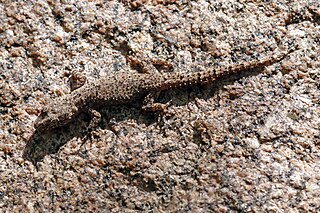 W
WBlaesodactylus sakalava, the Sakalava velvet gecko is a species of gecko endemic to Madagascar.
 W
WThe brown mantella is a species of frog in the family Mantellidae. It is endemic to Madagascar. Its natural habitats are subtropical or tropical dry forests, dry savanna, moist savanna, subtropical or tropical dry shrubland, rivers, freshwater marshes, intermittent freshwater marshes, rural gardens, heavily degraded former forest, ponds, and canals and ditches. It is threatened by habitat loss.
 W
WCoeliades ernesti is a butterfly in the family Hesperiidae. This species originates from Madagascar but was also introduced to Réunion and Mauritius (1980). Their habitat consists of forests, secondary forests and anthropogenic areas.
 W
WTomato frogs are any of the three species of genus Dyscophus : D. antongilii, D. insularis, or D. guineti. Dyscophus is the only genus in subfamily Dyscophinae. They are endemic to Madagascar. The three Dyscophus species differ in chromatin pattern. Both sexes of D. guineti show a heteromorphic chromosome pair 11, with one element larger (11a) than the other 11b due to the presence of the large terminal tract on the short arm with an euchromatic band enclosed between two heterochromatic bands. This condition in dyscophus probably characterizes the beginning of a cladogenetic process.
 W
WDyscophus antongilii, the Madagascar tomato frog, is a species of frog in the family Microhylidae.
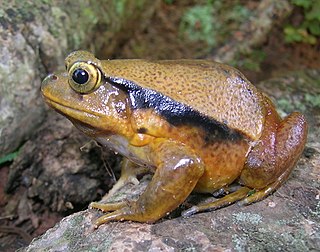 W
WDyscophus guineti, the false tomato frog or the Sambava tomato frog, is a species of frog in the family Microhylidae. It is endemic to Madagascar. Its natural habitats are subtropical or tropical moist lowland forest, subtropical or tropical swamps, swamps, freshwater marshes, intermittent freshwater marshes, and heavily degraded former forest. It is threatened by habitat loss.
 W
WDyscophus insularis is a species of frog in the family Microhylidae. It is endemic to western Madagascar . Its natural habitats are subtropical or tropical dry forests, subtropical or tropical moist lowland forests, dry savanna, moist savanna, intermittent rivers, and intermittent freshwater marshes. It is threatened by habitat loss.
 W
WThe Madagascan big-headed turtle is a turtle native to the waters of permanent slow moving rivers and lakes in western Madagascar. These turtles are critically endangered and have been evaluated to be the most endangered turtle in the world by a 2018 review. Despite their vulnerability to extinction, they are commonly eaten for food and they are still commonly shipped from Madagascar to Asia to help meet the demand of Asia's traditional medicine market. A captive breeding program has also been started to prevent the species from becoming extinct. The Turtle Conservation Fund (TCF) intends to raise US$5.6 million to cover a five-year 'Global Action Plan' which includes captive breeding and reintroduction projects, trade monitoring, new rescue centers, local conservation plans, and educational programs.
 W
WFlat-backed spider tortoise, more commonly known as the flat-tailed tortoise, and Madagascan flat-tailed tortoise, is a tortoise that belongs to the family Testudinidae. The various common names for this small tortoise usually refer to the noticeably flattened nature of its oblong upper-shell or its tail.
 W
WGeckolepis is a genus of geckos, commonly referred to as fish scale geckos, which are endemic to Madagascar and the Comoro Islands. They are nocturnal, arboreal, insectivorous lizards, found in primary and secondary forest, as well as degraded habitats. They are best known for their ability to lose their skin and scales when grasped by a predator.
 W
WThe large-eared tenrec is a species of mammal in the family Tenrecidae. It is the only species in the monotypic genus Geogale, and the only member of the subfamily Geogalinae. It is endemic to Madagascar where its natural habitats are subtropical or tropical dry forests and subtropical or tropical dry shrubland. It is threatened by habitat loss, but to a lesser extent than was previously thought and is listed by the IUCN as being of "Least Concern".
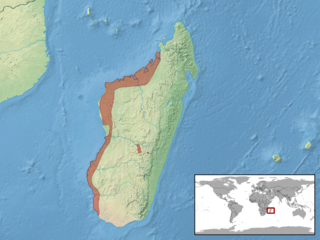 W
WGrandidier's dwarf gecko is a species of lizard in the family Gekkonidae. The species is endemic to Madagascar.
 W
WGrandidier's gecko is a species of lizard in the family Gekkonidae. It is endemic to Madagascar.
 W
WHeterixalus betsileo is a species of frogs in the family Hyperoliidae endemic to Madagascar. Its natural habitats are subtropical or tropical moist lowland forests, subtropical or tropical moist montane forests, moist savanna, subtropical or tropical seasonally wet or flooded lowland grassland, subtropical or tropical high-altitude grassland, swamps, freshwater marshes, intermittent freshwater marshes, arable land, rural gardens, urban areas, heavily degraded former forests, ponds, irrigated land, seasonally flooded agricultural land, and canals and ditches.
 W
WHypogeomys is a genus of rodents in the family Nesomyidae, found in Madagascar. There is one extant species, the Malagasy giant rat, currently an endangered species with a restricted range. There is also another species known from subfossils from a few thousand years ago, Hypogeomys australis. H. antinema measures 33 centimetres (13 in), making it the largest rodent in Madagascar, while H. australis seems to have been slightly larger.
 W
WThe large-eared tenrec is a species of mammal in the family Tenrecidae. It is the only species in the monotypic genus Geogale, and the only member of the subfamily Geogalinae. It is endemic to Madagascar where its natural habitats are subtropical or tropical dry forests and subtropical or tropical dry shrubland. It is threatened by habitat loss, but to a lesser extent than was previously thought and is listed by the IUCN as being of "Least Concern".
 W
WThe Madagascan big-headed turtle is a turtle native to the waters of permanent slow moving rivers and lakes in western Madagascar. These turtles are critically endangered and have been evaluated to be the most endangered turtle in the world by a 2018 review. Despite their vulnerability to extinction, they are commonly eaten for food and they are still commonly shipped from Madagascar to Asia to help meet the demand of Asia's traditional medicine market. A captive breeding program has also been started to prevent the species from becoming extinct. The Turtle Conservation Fund (TCF) intends to raise US$5.6 million to cover a five-year 'Global Action Plan' which includes captive breeding and reintroduction projects, trade monitoring, new rescue centers, local conservation plans, and educational programs.
 W
WMantella madagascariensis, common names Malagasy painted mantella, Madagascan mantella, Madagascar golden frog, Malagasy mantella and painted mantella, is a species of frog in the family Mantellidae.
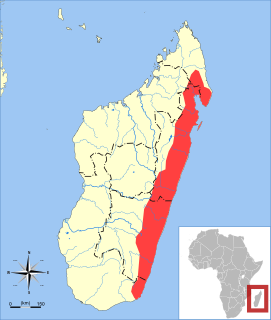 W
WThe Madagascar sucker-footed bat, Old World sucker-footed bat, or simply sucker-footed bat is a species of bat in the family Myzopodidae endemic to Madagascar, especially in the eastern part of the forests. The genus was thought to be monospecific until a second species, Myzopoda schliemanni, was discovered in the central western lowlands. It was classified as Vulnerable in the 1996 IUCN Red List of Threatened Species but is now known to be more abundant and was reclassified in 2008 as of "Least Concern".
 W
WThe Malagasy giant rat, also known as the votsotsa or votsovotsa, is a nesomyid rodent found only in the Menabe region of Madagascar. It is an endangered species due to habitat loss, slow reproduction, and limited range Pairs are monogamous and females bear only one or two young per year. It is the only extant species in the genus Hypogeomys; another species, Hypogeomys australis, is known from subfossil remains a few thousand years old.
 W
WMimophis mahfalensis, also known as the common big-eyed snake, is a species of snake in the family Lamprophiidae. It is endemic to Madagascar and occurs in the central and southern parts of the island; the northern population has been splitt off as a separate species, Mimophis occultus.
 W
WMyzopoda, which has two described species, is the only genus in the bat family Myzopodidae. Myzopodidae is unique as the only family of bats presently endemic to Madagascar. However, fossil discoveries indicate that the family has an ancient lineage in Africa, extending from the Pleistocene as far back as the late Eocene. Based on nuclear DNA sequence data, Myzopodidae appears to be basal in the Gondwanan superfamily Noctilionoidea, most of whose members are neotropical. The origin and initial diversification of Noctilionoidea may have occurred in Africa prior to their dispersal to Australia and South America, probably via Antarctica. On the basis of fossil and molecular clock evidence, myzopodids are estimated to have split off from the rest of Noctilionoidea about 50 million years ago.
 W
WOplurus fierinensis, also known as the Anzamala Madagascar swift or Madagascar blue iguana, is a saxicolous iguana endemic to Madagascar.
 W
WRice tenrecs are the two species in the Malagasy genus Oryzorictes. They are mammals in the family Tenrecidae. It contains the following species:Mole-like rice tenrec Four-toed rice tenrec
 W
WPygomeles is a genus of skinks, lizards in the family Scincidae. The genus is endemic to Madagascar.
 W
WRice tenrecs are the two species in the Malagasy genus Oryzorictes. They are mammals in the family Tenrecidae. It contains the following species:Mole-like rice tenrec Four-toed rice tenrec
 W
WThe running coua is a species of cuckoo in the family Cuculidae. It is endemic to Madagascar.
 W
WTomato frogs are any of the three species of genus Dyscophus : D. antongilii, D. insularis, or D. guineti. Dyscophus is the only genus in subfamily Dyscophinae. They are endemic to Madagascar. The three Dyscophus species differ in chromatin pattern. Both sexes of D. guineti show a heteromorphic chromosome pair 11, with one element larger (11a) than the other 11b due to the presence of the large terminal tract on the short arm with an euchromatic band enclosed between two heterochromatic bands. This condition in dyscophus probably characterizes the beginning of a cladogenetic process.
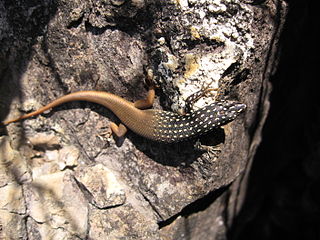 W
WTrachylepis aureopunctata, the gold-spotted mabuya, is a species of skink. It is endemic to Madagascar.
 W
WVerreaux's coua is a species of cuckoo in the family Cuculidae. It is endemic to Madagascar. According to a BBC documentary, it is found only near a salt lake in the southern part of the island. The lake is 16 km long but only a couple of metres deep. The area has been drying out for the last 40,000 years and the organisms living here have become adapted to conserve water.